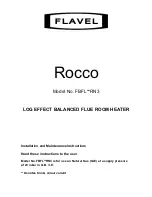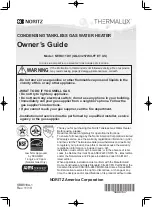
1.
Read all safety precautions and follow L. B. White
recommendations when installing this heater. If
during the installation or relocating of heater, you
suspect that a part is damaged or defective, call a
qualified service agency for repair or replacement.
2.
Ensure the heater is properly positioned before use.
The heater must be installed on a level, flat,and
stable surface when in operation and according to
minimum safe distances from combustible materials.
Safe distances are given on the heater dataplate and
on page 4 of this manual.
3.
L.P Gas Installation Requirements
■
Ensure all L.P. gas containers are secured and
protected from all people, vehicular traffic and
contact.
■
L.P. gas containers must be located on a flat,level,
and stable surface.
■
L.P. gas cylinders (a.k.a. 100 lb. cylinders/tanks)
must be secured from tip-over.
Contact your local authorities, L.P. gas dealers, or fire
marshalls for specifics dealing with installation in
your area
4.
This heater is approved for either indoor or outdoor
use.
5.
The heater’s gas pressure regulator (with pressure
relief valve) must be protected from adverse weather
conditions (rain, ice, snow) as well as from building
materials (tar, concrete, plaster, etc.) which can affect
safe operation and could result in property damage or
injury.
6.
Heaters used in the vicinity of combustible tarpaulins,
canvas, plastics, wind barriers, or similar coverings
shall be located at least 10 feet from the coverings.
The coverings shall be securely fastened to prevent
ignition or upsetting of the heater due to wind action
on the covering or other material.
7.
Insure that all accessories that ship with the heater
have been and installed.
8.
Check all connections for gas leaks using approved
gas leak detectors. Gas leak testing is performed as
follows:
-- Check all pipe connections, hose connections,
fittings and adapters upstream of the gas
control with approved gas leak detectors.
-- In the event a gas leak is detected, check the
components involved for cleanliness and
proper application of pipe compound before
further tightening.
-- Tighten the gas connections as necessary to
stop the leak.
-- After all connections are checked and any
leaks are stopped, turn on the main burner.
-- Stand clear while the main burner ignites to
prevent injury caused from hidden leaks that
could cause flashback.
-- With the main burner in operation, check all
connections, hose connections, fittings and
joints as well as the gas control valve inlet and
outlet connections with approved gas leak
detectors.
-- If a leak is detected, check the components
involved for cleanliness in the thread areas
and proper application of pipe compound
before further tightening.
-- Tighten the gas connection as necessary to
stop the leak.
-- If necessary, replace the parts or components
involved if the leak cannot be stopped.
-- Ensure all gas leaks have been identified and
repaired before proceeding.
9.
A qualified service agency must check for proper
operating gas pressure upon installation of the
heater.
10.
Always use pipe thread compund that is resistant to
propane and natural gas.
11.
Light according to instructions on heater or within
owner's manual.
WARNING
Fire and Explosion Hazard
Can cause property damage, severe injury or death
To avoid dangerous accumulation of fuel gas, turn
off gas supply at the heater service valve before
starting installation, and perform gas leak test after
completion of installation.
7
Installation and Assembly Instructions
GENERAL
WARNING
Fire and Explosion Hazard
■
Do not use open flame (matches, torches, candles,
etc.) in checking for gas leaks.
■
Use only approved leak detectors.
■
Failure to follow this warning can lead to fires or
explosions.
■
Fires or explosions can lead to property damage,
Содержание CP155
Страница 2: ......
Страница 28: ...27 PARTS SCHEMATIC Parts Identification...









































